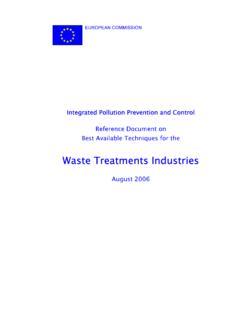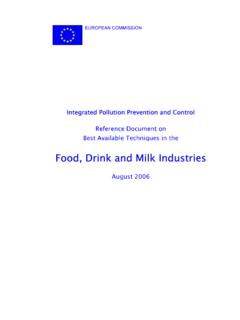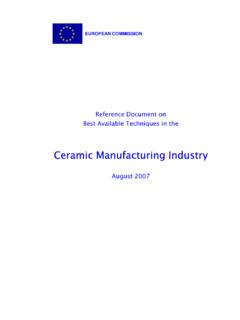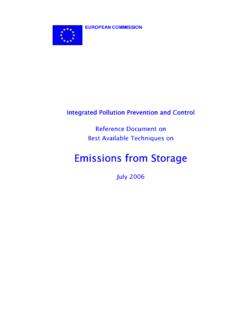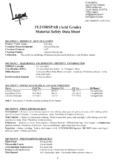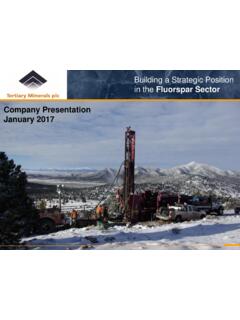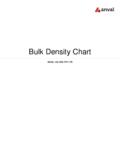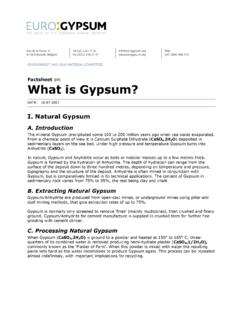Transcription of Large Volume Inorganic Chemicals - Solids and Others industry
1 EUROPEAN COMMISSION Integrated Pollution Prevention and Control Reference Document on Best Available Techniques for the Manufacture of Large Volume Inorganic Chemicals - Solids and Others industry August 2007 This document is one of a series of foreseen documents as below (at the time of writing, not all documents have been completed): Reference Document on Best Available Techniques .. Code Large Combustion Plants LCP Mineral Oil and Gas Refineries REF Production of Iron and Steel I&S Ferrous Metals Processing industry FMP Non Ferrous Metals Industries NFM Smitheries and Foundries industry SF Surface Treatment of Metals and Plastics STM Cement and Lime Manufacturing Industries CL Glass Manufacturing industry GLS Ceramic Manufacturing industry CER Large Volume Organic chemical industry LVOC Manufacture of Organic Fine Chemicals OFC Production of Polymers POL Chlor Alkali Manufacturing industry CAK Large Volume Inorganic Chemicals - Ammonia.
2 Acids and Fertilisers Industries LVIC-AAF Large Volume Inorganic Chemicals - solid and Others industry LVIC-S Production of Speciality Inorganic Chemicals SIC Common Waste Water and Waste Gas Treatment/Management Systems in the chemical Sector CWW Waste Treatments Industries WT Waste Incineration WI Management of Tailings and Waste-Rock in Mining Activities MTWR Pulp and Paper industry PP Textiles industry TXT Tanning of Hides and Skins TAN Slaughterhouses and Animals By-products Industries SA Food, Drink and Milk Industries FDM Intensive Rearing of Poultry and Pigs ILF Surface Treatment Using Organic Solvents STS Industrial Cooling Systems CV Emissions from Storage ESB Reference Document.
3 General Principles of Monitoring MON Economics and Cross-Media Effects ECM Energy Efficiency Techniques ENE Electronic versions of draft and finalised documents are publically available and can be downloaded from Summary Large Volume Inorganic Chemicals Solids and Others i EXECUTIVE SUMMARY Introduction The BAT (Best Available Techniques) Reference Document (BREF) entitled Large Volume Inorganic Chemicals Solids and Others (LVIC-S) industry reflects an information exchange carried out under Article 16(2) of Council Directive 96/61/EC (IPPC Directive).
4 This Executive Summary describes the main findings, a summary of the principal BAT conclusions and the associated consumption and emission levels. It should be read in conjunction with the preface, which explains this document s objectives; how it is intended to be used and legal terms. It can be read and understood as a standalone document but, as a summary, it does not represent all the complexities of this full document. It is therefore not intended as a substitute for this full document as a tool in BAT decision making. Scope of this document The BREF on the LVIC-S industry is a neighbour to the Chlor-alkali (CAK), Large Volume Inorganic Chemicals Ammonia, Acids and Fertilisers (LVIC-AAF), and Speciality Inorganic Chemicals (SIC) BREFs.
5 Ahomogeneous and strictly defined LVIC-S industry does not really exist, and there no clear borderlines between the above-mentioned four Inorganic chemical industry groups and the four associated BREFs. The scope of this document is, in principle, relevant to industrial activities covered in Annex I to the IPPC Directive (96/61/EC) Section chemical installations for the production of basic Inorganic Chemicals , in particular to activities covered in points and Annex I to the IPPC Directive does not give any threshold value of the capacity for chemical industry plants, neither does it define the concepts of Large Volume , cornerstone and selected illustrative LVIC-S products used in this document, however, the following criteria were adopted for the selection of the processes covered in this document.
6 Scale and economic importance of the production number of plants and their distribution in different Member States impact of a given industry on the environment accordance of the industrial activities with the structure of Annex I to the Directive representativeness for a wide range of technologies applied in the LVIC-S industry validated data and information on LVIC-S products sufficient to formulate Techniques to consider in the determination of BAT and to draw BAT conclusions for the manufacture of these products. The LVIC-S products addressed in this document include: I.
7 Five products at the so-called cornerstone level, addressed in Chapters 2 through to 6: soda ash (sodium carbonate, including sodium bicarbonate) titanium dioxide (chloride and sulphate process routes) carbon black (rubber and speciality grades) synthetic amorphous silica (pyrogenic silica, precipitated silica, and silica gel) Inorganic phosphates (detergent, food and feed phosphates). Executive Summary ii Large Volume Inorganic Chemicals Solids and Others II. 17 LVIC-S products at the so-called selected illustrative level, addressed at a lesser level of detail in Chapter 7 (Sections to ): aluminium fluoride (two process routes.)
8 Starting from fluorspar and from fluosilicic acid) calcium carbide (a high temperature electrothermic process, starting from lime and carbon) carbon disulphide (the methane process, based on the reaction of sulphur with natural gas) ferrous chloride (the process-integrated with the production of TiO2by the chloride route) copperas and related products (co-products in the manufacture of TiO2by the sulphate route) lead oxide (production processes for the manufacture of red lead and litharge, from pure lead) magnesium compounds (produced by the wet process route to magnesium chloride and oxide) sodium silicate (covering the production of water glass by the melting and hydrothermal routes) silicon carbide (a high temperature electrochemical process starting from silica and carbon) zeolites (production processes to synthetic aluminosilicates, including zeolites A and Y) calcium chloride (processes routes related to soda ash and magnesia, and the HCl-CaCO3route)
9 Precipitated calcium carbonate (production by the reaction of calcium hydroxide with CO2) sodium chlorate (produced by the electrolysis of an aqueous solution of sodium chloride) sodium perborate (produced by the reaction of borax and NaOH, and the reaction with H2O2) sodium percarbonate (produced by the crystallisation and the spray-granulation process routes) sodium sulphite and related products (the family of sodium products obtained by the reaction of SO2with an alkali) zinc oxide (obtained by the direct process, the five indirect processes, and the chemical process).
10 The following points indicate the main structure of this document: the executive Summary gives concise information on the main findings from the chapters in this document the preface explains the status and objectives of this document, and how to use it the scope gives details on the scope of the TWG work and the structure of this document Chapter 1 gives a general description of the LVIC-S industry , its potential and characteristics Chapters 2, 3, 4, 5 and 6 give description of five cornerstone LVIC-S products, including a BAT chapter for each cornerstone product Chapter 7 gives descriptions of 17 selected illustrative LVIC-S groups of processes.



